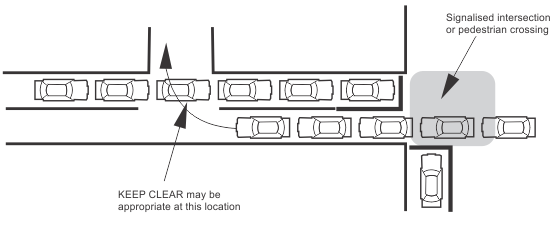Policy and Guidelines for KEEP CLEAR Pavement Marking
Table of Contents
1. Policy Statement
Main Roads Western Australia will install and maintain KEEP CLEAR pavement marking where traffic blocking intersections significantly impedes traffic flow and safety along distributor routes.
This policy and guidelines does not include Keep Clear requirements at railway level crossings and Principal Shared Paths, which are the subject of separate documents.
2. Preliminary
2.1 Definitions
Unless otherwise indicated in the text of this Guideline:
Emergency Service Facility means ambulance depot, fire station, hospitals with emergency departments.
Pedestrian Crossing Facility means a signalised pedestrian crossing, zebra crossing or children's crossing.
Main Roads means Main Roads Western Australia.
VPD means vehicles per day.
2.2 Background
Vehicles queuing across intersections or junctions can significantly restrict traffic flow and create hazardous situations for other road users. In accordance with Road Traffic Code 2000 Regulation 111 (1) drivers shall not enter or attempt to cross an intersection if the intersection or carriageway beyond it is blocked.
The use of KEEP CLEAR markings should be limited to situations where traffic blocking intersections significantly impedes traffic flow or has the potential to create hazardous situations for other road users. It shall be primarily installed to improve the ability of drivers to exit the major road and is not intended for the purpose of improving access from the minor road.
2.3 Purpose
The purpose of this document is to detail Main Roads requirements for use of and location of KEEP CLEAR pavement marking on applicable routes.
Main Roads primary objective of these guidelines is to allow practitioners to determine where KEEP CLEAR marking may improve traffic efficiency without compromising safety of road users.
3. Application Guidelines
3.1 Applicable Routes
KEEP CLEAR pavement marking shall only be used in urban areas and restricted to intersections, T-junctions, some emergency driveways to assist emergency vehicles and in some instances to assist public transport buses.
3.2 Conditions
Main Roads specific requirements for the installation of KEEP CLEAR marking are as follows:
- Posted speed limit shall be 70km/h or less,
- Drivers are regularly forced to wait for a period greater than two traffic signal cycle lengths, or delayed over 3.5 minutes at a time,
- Public transport buses are regularly forced to wait for a period greater than 30 seconds,
- A minor road connects to a major road close to a signalised intersection and traffic held by a red signal on the major road regularly blocks right turn access into the minor road,
- Sites shall be assessed at least 3 times on different days of the week, at a time nominated by the applicant and during peak traffic time to measure and log delays. Video survey may be used to assist in assessment.
3.2.1 Intersections
KEEP CLEAR marking at a 4 way intersection should not be installed unless:
- Two signalised intersections are in close proximity to each other and vehicles are regularly queuing through to the downstream intersection and preventing other vehicles to enter or cross the intersection,
- The intersection is fully congested (peak hour traffic exceeds 800 vehicles per hour per lane).
3.2.2 T-Junctions
At most minor roads near signalised intersections or crossings, it should be accepted that drivers will inadvertently block the minor road junction. The use of KEEP CLEAR marking is not warranted if this occurs occasionally during heavy traffic conditions.
KEEP CLEAR marking at a T-junction may be considered where:
- The T-junction is in close proximity to a signalised intersection or another junction and queued vehicles are blocking right turn access to the minor road, resulting in vehicles regularly queuing behind the right turning vehicles extending back into the preceding intersection and preventing other vehicles to enter or cross the intersection.
- The T-junction is in close proximity to a pedestrian crossing facility where, as a result of numerous crossing activations, queued vehicles are blocking right turn access to the minor road, resulting in vehicles regularly queuing behind the right turning vehicles extending back into the preceding crossing at the same time the crossing is active and pedestrians are crossing the road.

Figure 1: Situation where KEEP CLEAR message may be used
3.2.3 Driveways
KEEP CLEAR marking shall not be used as a device to minimise delays to vehicles entering or leaving private or business properties. KEEP CLEAR marking shall not be installed for private residences, shopping and commercial centres and / or business car parks.
KEEP CLEAR marking at an Emergency Service Facility may be considered where:
- The driveway is less than 30 m from an signalised intersection,
- Emergency access to the road in both directions is used frequently and vehicles are regularly queuing across the driveway.
4. Approval Guidelines
4.1 Applications
Applications for KEEP CLEAR pavement marking should be addressed to the Traffic Services Co-ordinator for the Metropolitan Region and the Regional Manager in the Regional Office.The applicant should provide the following information:
Applicants Name, Postal Address, E-mail Address and Telephone Number,Road Name and Section (linked to a physical landmark eg intersection),
Nature of the problem (traffic regularly blocking intersection or emergency driveway).
4.2 Approval
KEEP CLEAR marking shall be approved by the Executive Director Road Network Services, prior to implementation